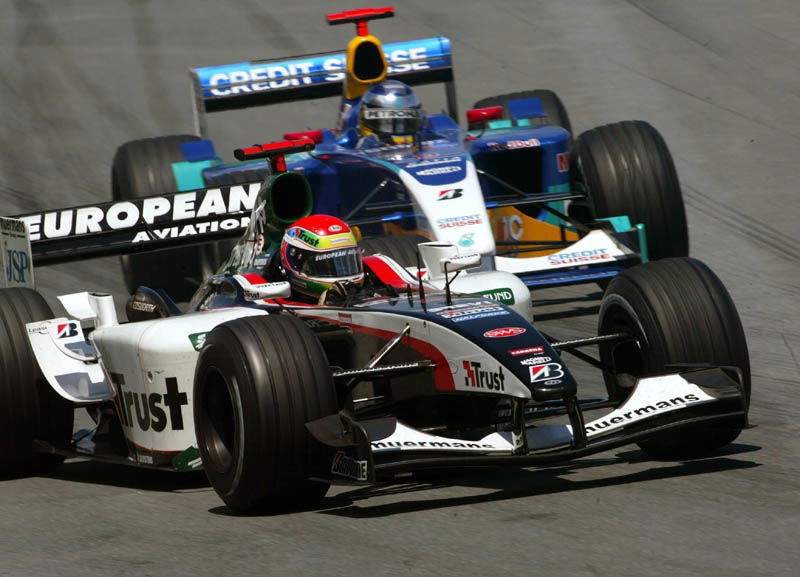Unsung hero - Geoffrey Willis.
Lucky Strike B.A.R Honda's technical director Geoffrey Willis has an intriguing CV, and unlike many of his contemporaries, he did not join in the world of motor racing straight from his studies.
He's done many other things, including making torpedoes more efficient, changing the face of the America's Cup, and pioneering Computational Fluid Dynamics - now a vital tool used by every motorsport designer.
Lucky Strike B.A.R Honda's technical director Geoffrey Willis has an intriguing CV, and unlike many of his contemporaries, he did not join in the world of motor racing straight from his studies.
He's done many other things, including making torpedoes more efficient, changing the face of the America's Cup, and pioneering Computational Fluid Dynamics - now a vital tool used by every motorsport designer.
"I have always been interested in how things work, building things and taking them apart," he says. "Although I was interested in almost everything at school, I was particularly interested in mathematics. Given the combined interests of "how" and "why", I read engineering rather than science at university."
And after gaining his engineering degree at Cambridge University in the early '80s, Willis joined British Maritime Technology in Teddington, Middlesex, where he plied his trade in submarine aerodynamics and hydrodynamics. BMT is a company well known in F1 circles through its collaboration with McLaren, who have developed and used one of its wind tunnels for aerodynamic testing for many years. While working for BMT he also gained his PhD in Engineering Science at Exeter University.
"After a few years working in a relatively academic environment in hydrodynamics research, and gaining a PhD on the way, I was approached by an America's Cup yacht syndicate to work as the team's hydrodynamicist where I was involved in analysis, simulation and testing for the design of racing yachts. It was a small team and I soon became involved in many other tasks such as structures, composites and new concept design. By chance, a consultant to the team was also consulting for an F1 team at the time and when the syndicate was wound up, I assisted the then chief designer of that F1 team, Adrian Newey in introducing CFD to aero design, which was new to F1 at the time.
"When Adrian moved to Williams shortly after, he invited me to join him. Starting as a CFD specialist I rapidly became more involved in the whole aerodynamic design process. Since aerodynamic design is so much at the core of modern F1 car design this brought me more and more into contact with all the other disciplines and on Adrian's departure to McLaren, I took on the role as Chief Aerodynamicist."
Wills was involved in the design of every Williams' cars between 1991 and 2002, but in late 2001 he jumped at the chance to expand his horizons by joining Lucky Strike B.A.R Honda.
"Coming to B.A.R has enabled me to take on the design task in its full range of challenges. It is a fantastic job, and I cannot think of one that would be better suited to someone who has an interest in almost everything, an enthusiasm for problem solving and the responsibility and reward of creating. It is a mixture of competition and challenges, problem solving, analysis and design, leadership and teamwork. The combination of the technical complexities together with the challenges of getting a group of highly talented people together to compete against others gives my job its continual reward."
With the job title of technical director, design is only one of Geoffrey Willis's tasks at Lucky Strike B.A.R Honda. He is also responsible for defining the technical strategy and overall targets, working with Honda to ensure both their engine and chassis programmes tie in with the car design and many of his responsibilities, while technical in nature, are more often to do with people management. The majority of his job is not track based but when he is there, ensuring good communication between the race engineers, the drivers and Honda engineers is essential. Willis is also the final arbiter when it comes to some of the trickier decisions at the track. As such, a good relationship with both drivers is essential.
"It's very important to get on well with the drivers because they can help you enormously in understanding what the car is doing and in interpreting the car data. It is important because the drivers have a detailed feel for the car and so the ability to communicate well with them, to understand them and earn their trust is important."
Away from the track Willis divides his time between directing the design team, ensuring that the partnership with Honda progresses in the right direction and making sure all the technical functions of the team are going in the right direction.
With what precious little free time he does manage to squeeze into this hectic schedule he enjoys many activities such as mountain biking and snow boarding as well as various cultural pursuits. Perhaps unsurprisingly, he also takes an interest in general forms of design away from his B.A.R Honda 005, both from an engineering point of view as well as the more aesthetically driven design of architecture, furniture and domestic items. He often considers how such objects were designed and how they were made.
"It might be surprising but one area I have never been very interested in is cars! Motorcycles definitely but never cars. For a while I considered becoming a civil engineer and worked, before university, for some consultant civil engineers who specialised in challenging bridge design so I am drawn towards big civil engineering projects. In terms of physical appearance, I like simple designs, elegant solutions where the shapes have logic to them and reflect my feeling that under everything lies a mathematical description."
